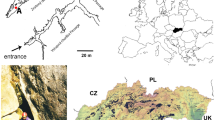Abstract
ONLY a few species of spiders and insects are known regularly to inhabit spider webs. Known associations involve predation or commensalism. Spiders of the family Mimetidae invade the webs of other spiders to devour the owner of the web. Small spiders of the genus Argyrodes (Theridiidae) are often seen in the webs of larger spiders, where they seem to consume only small insects ignored by the spiders that constructed the web; this relationship is thus commensalism and not parasitism2. The insect Ranzovius (Hemiptera: Miridae) seems to be a commensal in the webs of certain spiders3; however, R. fennahi may be predaceous on spider eggs4. The tropical hummingbird, Phaethornis superciliosus, has been observed feeding on insects trapped in webs of Nephila clavipes (Araneidae). The hummingbird–Nephila association may be parasitism because although only very small insects are taken by hummingbirds, they may remove a portion of the host's web for nest material5. I report here the kleptoparasitism of the prey of web-building spiders by scorpionflies of the genus Panorpa (Panorpidae), and I consider a likely selective context for the evolution of this unusual feeding strategy in scorpionflies. Field observations were conducted in south-eastern Michigan near Ann Arbor during 1971–74 (ref. 6).
This is a preview of subscription content, access via your institution
Access options
Subscribe to this journal
Receive 51 print issues and online access
$199.00 per year
only $3.90 per issue
Buy this article
- Purchase on Springer Link
- Instant access to full article PDF
Prices may be subject to local taxes which are calculated during checkout
Similar content being viewed by others
References
Kaston, B. J., State geol. nat. Hist. Surv. Conn. Bull. No. 70 (1948).
Exline, H., and Levi, H. W., Harvard Bull. Mus. comp. Zool., 127, (1962).
Davis, R. M., and Russell, M. P., Psyche, 76, 262–269 (1969).
Calvalho, J. C. M., Ann. Mag. Nat. Hist., 74, 92–96 (1954).
Young, A. M., Condor, 73, 36–45 (1971).
Thornhill, R., thesis, Univ. Michigan (1974).
Eisner, T., Science, 184, 996 (1974).
Eisner, T., in Chemical Ecology (edit. by Sondheimer, E., and Simeone, J. B.), 157–217 (Academic, New York, 1970).
Author information
Authors and Affiliations
Rights and permissions
About this article
Cite this article
THORNHILL, R. Scorpionflies as kleptoparasites of web-building spiders. Nature 258, 709–711 (1975). https://doi.org/10.1038/258709b0
Received:
Accepted:
Issue Date:
DOI: https://doi.org/10.1038/258709b0
This article is cited by
-
Ability makes a thief: vision, learning, and swift escape help kleptoparasitic hover wasps not to fall prey to their spider hosts
Behavioral Ecology and Sociobiology (2019)
-
Kleptoparasites influence foraging behaviour of the spider Stegodyphus lineatus (Araneae, Eresidae)
Insectes Sociaux (2011)
-
The escape strategy of green lacewings from orb webs
Journal of Insect Behavior (1990)
-
Why do only certain insects escape from a spider's web?
Oecologia (1982)
-
Die ökologische Bedeutung der Spinnen in Forst-Ökosystemen, eine Literaturzusammenstellung
Anzeiger für Schädlingskunde Pflanzenschutz Umweltschutz (1982)
Comments
By submitting a comment you agree to abide by our Terms and Community Guidelines. If you find something abusive or that does not comply with our terms or guidelines please flag it as inappropriate.



